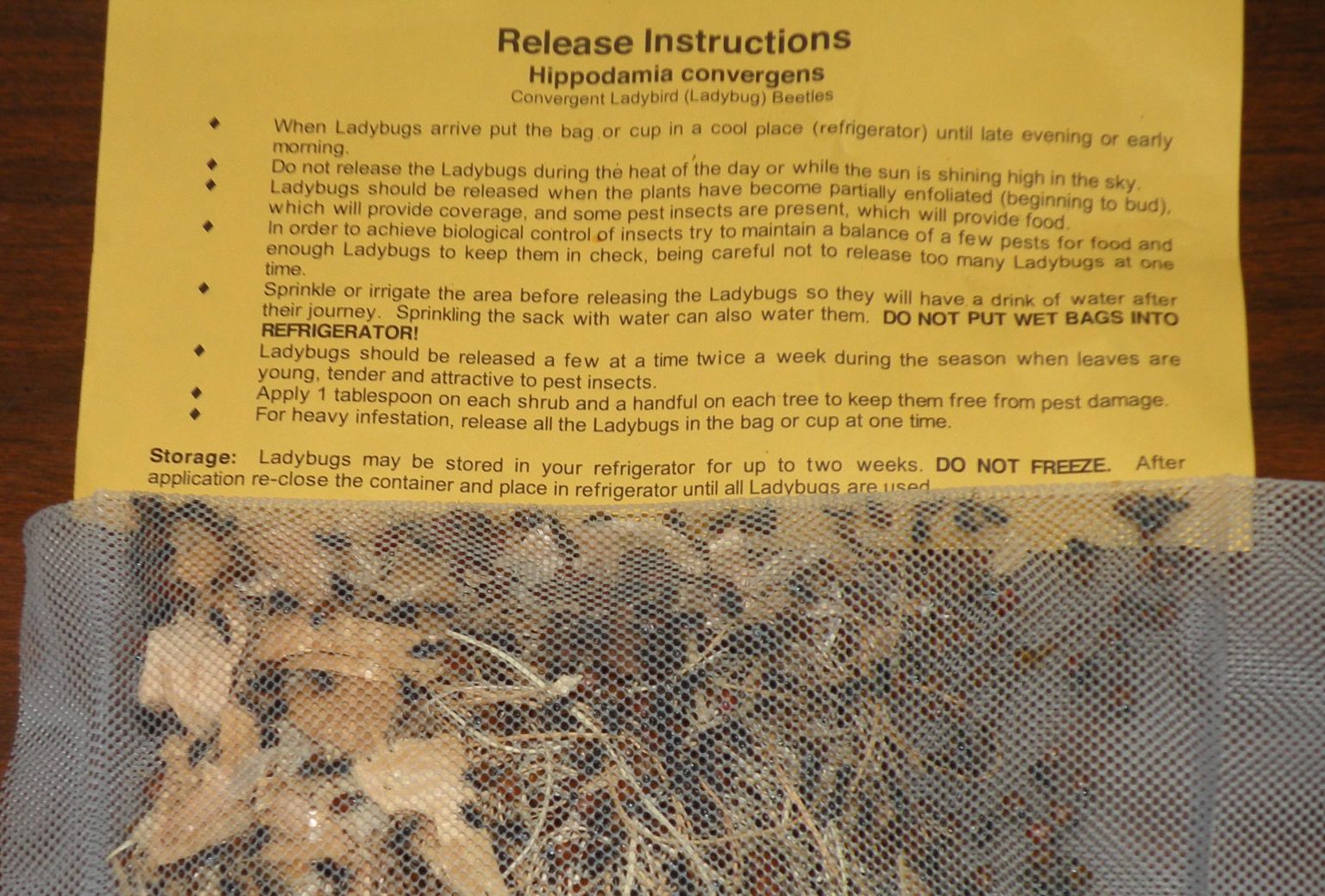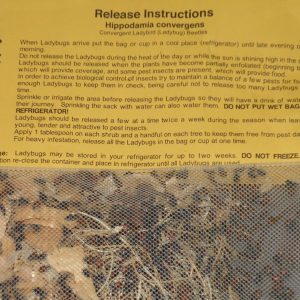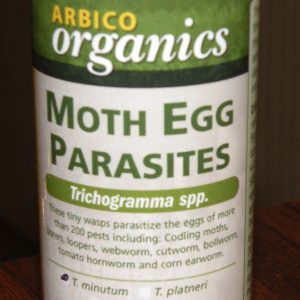Farming

Biological control agents (BCAs) are insects and pathogens, or microbes, that control crop pests. Specific BCAs for commercial vegetable production include parasitic wasps and predatory insects.
Vegetable growers often ask about using natural enemies and commercial biological control agents in their integrated pest management (IPM) strategies. Biological control agents (BCAs) are insects and pathogens, or microbes, that control crop pests. Specific BCAs for commercial vegetable production include parasitic wasps and predatory insects. Before using a BCA, always determine which practices will help conserve natural enemies and proper identification. In general, a BCA is most successful when combined with a protected production system such as a greenhouse, high tunnel, or netted structure. Refer to other publications in this series to learn about the high tunnel pest exclusion system that allows for augmentation of natural enemies.
- Figure 1. Lady beetles (Hippodamia convergens)
- Figure 2. NemaSeek (Heterorhabditis bacteriophora)
- Figure 3. Egg parasite (Trichogramma minutum)
Additional tips for successful use of BCAs are as follows:
- Use the correct species at the right time, and monitor insecticide use.
- Select insect species that are effective and easy to handle.
- Ensure that the release of beneficial organisms is synchronized with the life cycle of the target pest and incorporate them with care. Remember, biologicals are living organisms.
- Be sure to purchase the parasitic wasp specific to an aphid or whitefly species. Table 1 shows a general list of insect parasitoids and predators. Search each by name when you are ready to purchase.
- Purchase early in the week to avoid insects dying in shipment. Contact the vendor in advance to schedule a shipment date.
- Keep release records, and limit the use of conventional or biological insecticides when using natural predators or parasitoids.
- Incorporate pest exclusion systems.
- Use an insect barrier fabric or row cover when introducing natural enemies to allow them to feed on small insects.
- Use a shade cloth for insect manipulation with a high tunnel pest exclusion (HTPE) system. As an example, a 50 percent shade-cloth- based exclusion system can help contain adult lacewings that are voracious feeders of small insects such as aphids, whiteflies, and thrips.
- Use trap crops.
- Use trap crops to increase plant biodiversity and reduce pest infestations on the main crop to reduce the need for spray applications. In large IPM research plots and field demonstrations, Extension specialists have seen an increase in parasitic tachinid flies and predators such as syrphid flies, lady beetles, and spiders that actively feed on leaf-footed bugs and other large pests.
- Know the vendors.
- Research which vendors sell natural enemies, for example, Arbico Organics, Gardens Alive, Kopert, and Rincon-Vitova Insectaries. Packaging will vary depending on species and quantity. Retailers provide quality products and customer service; feel free to call and ask questions about product mailing and release methods.
- Know in advance the pest species you are trying to manage and the approximate area where you want to implement a biological control plan. This will allow vendors to stagger the mailing of BCAs on a weekly basis and not all at once.
Table 1. Commercially Available Predators and Parasitoids for Integrated Pest Management of Major Specialty Crop Pests
| Target Pest Group | Predator Species (commercial example) | Parasitoid (commercial example) | Remarks |
|---|---|---|---|
| Aphids, whiteflies, thrips (sucking insects) | Lady beetles (Hippodamia convergens) See figure 1. Lacewings (Chrysoperla rufilabris) Assassin bugs (Zelus renardii) Minute pirate bugs (Orius insidiosus) | Aphidius colemani Aphidius ervi (for potato aphid) Aphelinus abdominalis (for potato aphid) | Release any species of beneficial insects in a staggered manner as aphid populations increase. Immature stages of these sucking insect pests are easier to control than flying adult stages. Release predators close to the aphid hot spot in field or high tunnel. Use larvae of predators for immediate control; otherwise, use adult stages in a mixed release. Monitor parasitization rates (aphid mummies) before and after release of parasitoids. |
| Caterpillars, borers | Lady beetles (Hippodamia convergens) Lacewings (Chrysoperla rufilabris) | Trichogramma minutum (egg parasite) See figure 3. | Synchronize the release of parasitoids with the egg stages of the pest. Use Trichogramma cards close to the site of infestation and stagger their release. Reduce spraying of crops and record effectiveness. |
| Grasshoppers, crickets | Semaspore Bait or Nolo Bait (microsporidian fungi, Nosema locustae) | Use at high rate in and around field edges or in grassy, weedy areas where grasshoppers are active, especially near nymphs hatching from eggs in the ground. These are more effective when applied at first and second instar stages. (insects 1⁄4′′ to 1⁄2′′ long) | |
| Soil insects (white grubs, wire worms, weevils) | NemaSeek (Heterorhabditis bacteriophora) See figure 2. NemAttack (Steinernema carpocasae) NemAttack Pro Sf (S. feltiae) | Heterorhabtidis nematodes are active predatory nematodes that seek out soft-bodied insects in the ground. Steinernema are appropriate for soil-based caterpillars and maggots. | |
| Spider mites (two-spotted spider mite is most common in Alabama) | Predatory mites include Phytoseiulus persimilis, Mesoseiulus longipes, Neoseiulus californicus, Galendromus occidentalis, etc. Predatory midges include Feltiella acarisuga for vegetable production Predatory beetle Stethorus punctillum for vegetable production | Deploy beneficial mites before an outbreak. Beneficial mites generally feed on all stages of pest species. Certain beneficial mites have unique environmental conditions needed for maximum benefits. |
A true IPM approach integrates pest prevention, control, and biocontrol tactics into an environmentally friendly solution. Contact your state’s Extension for details about IPM tactics and to design a plan that suits your farm. The new Organic Vegetable IPM Slide Chart has many trap crop, pest exclusion, and bioinsecticide use recommendations that can help protect natural enemies. Visit www.alabamabeginningfarmer.com for more educational materials.
 Ayanava Majumdar, Extension Professor, Entomology and Plant Pathology, Auburn University, and State SARE Program Coordinator
Ayanava Majumdar, Extension Professor, Entomology and Plant Pathology, Auburn University, and State SARE Program Coordinator
New August 2021, Practical Tips for Using Biological Control Agents, ANR-2720




